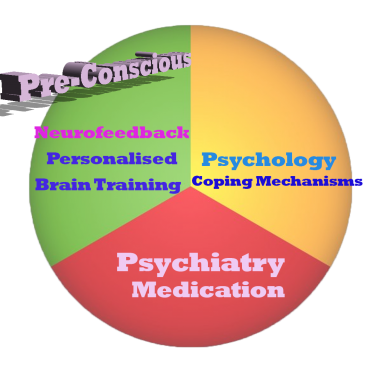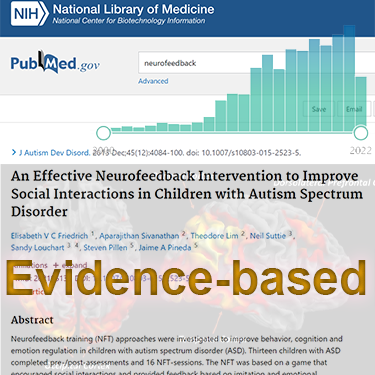Addiction can take many forms, but the single greatest misunderstanding is that of attributing addiction to a lack of self-discipline. This is simply not true – addiction is a physiological issue that can take a range of debilitating forms in a persons life. It needs to be seen as such to be able to formulate a recovery plan that goes beyond the multi-step programs often rooted in faith or even internment in expensive rehabilitation clinics, mostly with a high risk of relapse.
Neurofeedback aims to address the brain disorder of addiction by retraining the brain. It teaches the brain how to become calm, focused and relaxed, thus creating a more desirable state of mind than what drugs offer in only a temporary and often incapacitating manner. Without resorting to medicine, neurofeedback lays the tracks for a healthy state of mind, creating a brain that can respond clearly and rationally to the impulses that prompt addictive behaviour in the first place. It helps create a mind that can adapt its arousal level to any situation as needed.
With neurofeedback training, the brain learns to self-regulate, to summon resources when needed and to switch off into a deep sleep for recovery when desired. It gives the person the freedom to observe their emotions, respond to situations as needed and generally retain a certain coolness in daily life that reflects a zone where the brain is neither having to be hyper-focussed (‘fight-or-flight mode’) nor overwhelmed and thus drawn to shut down and rest. Neurofeedback calms the body and the mind, restores a healthy sense of self-worth, and adds cheerfulness in a measure that’s genuine and organic.
Addictions often arise as a reaction to undigested negative experiences, or trauma. Putting the mind in a state where it can relax and start dealing with this is a key goal. At first, symptoms such as hyper-vigilance, insomnia, anger and over-excitability are addressed. Then, we use Alpha Theta neurofeedback training to help the brain deal with the unresolved issues. Alpha Theta neurofeedback training holds the person in a state of deep relaxation, where memories can safely surface and as a result be processed. The idea is that traumatic memories are put into long-term storage, where they can be recalled from, without the adverse emotional state attached to them.
Scott & Peniston Study: Treating Alcoholism with Neurofeedback
Alcoholics produce measurably less alpha activity. In 1993 Scott and Peniston conducted a neurofeedback study with 24 veterans with PTSD and alcoholism, training alpha-theta while inhibiting delta activity to prevent reliving trauma. Participants likened the experience to observing their past behaviour from an emotionally neutral vantage point. It was found that 12-18 months later, none of the participants suffered from PTSD, and 79% had remained abstinent from alcohol and substance abuse.
Neurofeedback is a form of complementary therapy and should not be seen as a replacement for conventional medicine. qEEG brain map-based neurofeedback training takes a more holistic approach to brain functioning, rather than just focusing on medical symptoms. It is not intended as a form of diagnosis nor medical intervention nor medical advice per the disclaimer.
“I used to smoke cannabis daily, not just to get to sleep, but to be creative, social, inspired and probably also to detach myself from my surroundings – as if to say, ‘it’s not really me, just my funny, slightly stoned side’. Neurofeedback helped me regain a sense of self-worth that is different from ‘me me me’, it made me confident and self-assured, and I actually enjoy sobriety more now that I realise that it’s not the weed that made me funny, that’s actually me!
I’ve started vlogging, I’m not ashamed to expose my personality in front of others, and I can get to sleep without smoking, which is great as I wake up with a fresh mind, get things done, and I’m still creative – not just that, I’m actually doing things with the ideas I have.
I still smoke occasionally, and I do enjoy it, just in a different way – for one, it’s no longer a stimulant, just a relaxant, and I can have great conversations and good times with friends. It’s weird, something I relied on to become animated has fallen into the shadow of my personality, it’s almost a drag as I know I’ll be hungover the next day so I really just reserve it for social occasions or special moments – that way I feel the effect much more strongly and it’s become a treasure, not a vice.”
– Jacy, Graphic Design and Social Media Freelancer
Note: NeurofeedbackIO does not endorse drug use.
Brain Maps and Personalised Brain Training Explained
Personalised Brain Training with Neurofeedback
Neurofeedback lets us train dysrythmic brain areas. With sensors comfortably fitted to the brain areas we want to train, we detect brainwave patterns real-time while watching a movie. When these patterns are inefficient, the volume drops momentarily. This is the feedback we are giving our brain, short and instantaneously.
The brain area we are training recognises this – while our conscious mind is focussed on the movie – and adjusts its behaviour to restore the normal volume. With repetition, throughout a session, learning occurs.
Meanwhile our conscious mind is solely focussed on the movie; the training process is passive in this sense.
The drop in volume is subtle, so we continue to understand the flow of the movie. No current or electrical stimulation is fed to the brain; sensors simply read brainwaves and the feedback is purely audio-visual.

Neurofeedback trains our Pre-Conscious Mind
Rather than engaging the conscious mind, which slows us down, we are training preconscious processes.
This equips us with the ability to live in the moment and attain our potential (if we have to resort to conscious control, we are not living in the moment).
We take a holistic approach to healthy brain self-regulation, rather than categorisation or diagnosis.
Personalised Brain Training is an advanced qEEG brain map-based approach to neurofeedback training developed by the founders of the field. Taking Othmer Method / ILF training methods further, it employs Default Network Training protocols as developed by David Kaiser.

Neurofeedback is Evidence-based
Neurofeedback training is an evidence-based complementary therapy. Its efficacy was first demonstrated some 50 years ago, and with advances in technology, training protocols have become more efficient and the feedback method – watching movies – thoroughly enjoyable.
Neurofeedback is evidence-based. It’s first application was discovered in 1971 when it was used to resolve intractable epilepsy.
There are over 2,000 peer-reviewed research reports on PubMed demonstrating efficacy across a number of pathologies.
In the US, it is an accepted complementary treatment for many challenges.